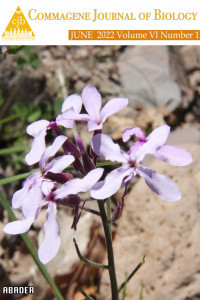Genç Haçlı Kara Kurbağaları İçin Diurnal Sığınak Alanı Olarak Bir Duvar Boşluğu
Birinci ve ikinci yılındaki Haçlı Kara kurbağaları (Epidalea calamita)'nın Hollanda kıyı kumullarının yakınında ilkbahardan sonbahara kadar bir binanın tuğla duvarında yer alan bir boşluğu ortak diurnal sığınak olarak kullandıkları tespit edilmiş ve aynı zamanda bu sığınağın kış sığınağı olabileceğinden şüphelenilmiştir. Sadece juveniller ve ikinci yılındaki bireyler gözlenmiştir. Daha büyük örnekler boşluğun önündeki metal ağdan dolayı girememiştir.
Anahtar Kelimeler:
Antropojenik habitat, barınak, ağ, hibernasyon
A Wall Cavity as a Diurnal Retreat Site for Young Natterjack Toads
First and second year Natterjack toads (Epidalea calamita) were detected around a building near the Dutch coastal dunes, using a brick wall cavity as a communal diurnal retreat site from spring until autumn, with the suspicion of this also being a winter refuge. Only juveniles and animals in their second year were seen. Bigger specimens were unable to enter due to the metal mesh in front of the openings.
Keywords:
Anthropogenic habitat shelter, mesh, hibernation, hibernation,
___
- Drobenkov, S.M. (2018). Morphological variation and population structure of the Natterjack toad, Epidalea calamita, in northern part of the range in Belarus. Biologica Universitatis Daugavpiliensis, 18(1), 29-37.
- Kordges, T. (2009): Zum Einsatz künstlicher Verstecke (KV) bei der Amphibienerfassung. Zeitschrift für Feldherpetologie, Supplement 15: 327-340.
- Miaud, C. & Sanuy, D. (2005). Terrestrial habitat preferences of the natterjack toad during and after the breeding season in a landscape of intensive agricultural activity. Amphibia-Reptilia 26(3), 359-366.
- Pikulik, M.M. (1995). Status and Dynamics of Amphibian Populations in Belarus and the Influence of Anthropogenic Factors on Amphibians. In S.L. Kuzmin, C.K. Dodd and M.M. Pikulik (Eds.), Amphibian populations in the Commonwealth of Independent States: current status and declines. Pensoft Publishers, Moscow, Russia (pp. 21-35).
- Yayın Aralığı: Yılda 2 Sayı
- Başlangıç: 2017
- Yayıncı: ABADER (Adıyaman Bilimsel Araştırmalar Derneği)
Sayıdaki Diğer Makaleler
Kuzey Irak Zakho İli Akrep Faunası ve Skorpionizmi
Türkiye’de Üretilen Isıl İşlem Görmüş Sucukların Mineral ve Yağ Asit Düzeylerinin Tespiti
Türkiye’deki Dorycnium hirsutum (Fabaceae) Taksonlarına Sistematik Katkılar
Yusuf Ziya KOCABAŞ, Ahmet İLÇİM
Sulak Alan Kıymetlendirme Yöntemleri
Fatma ÜÇEŞ, Mehmet Zülfü YILDIZ
Umut verici bir tıbbi bitkinin inulinaz üretim kapasitesi: Inula viscosa
Mustafa Güçlü SUCAK, Ahmet ÖZKAYA, Oğuz AĞYAR, Selma BEYZİ BÜYÜKKILIÇ, Uğur KARA, Zeynep ŞAHAN, Uğur SERBESTER
Genç Haçlı Kara Kurbağaları İçin Diurnal Sığınak Alanı Olarak Bir Duvar Boşluğu
